With no interference from the Moon, this year’s Perseid meteor shower should be excellent. Find a dark location and enjoy every flash.
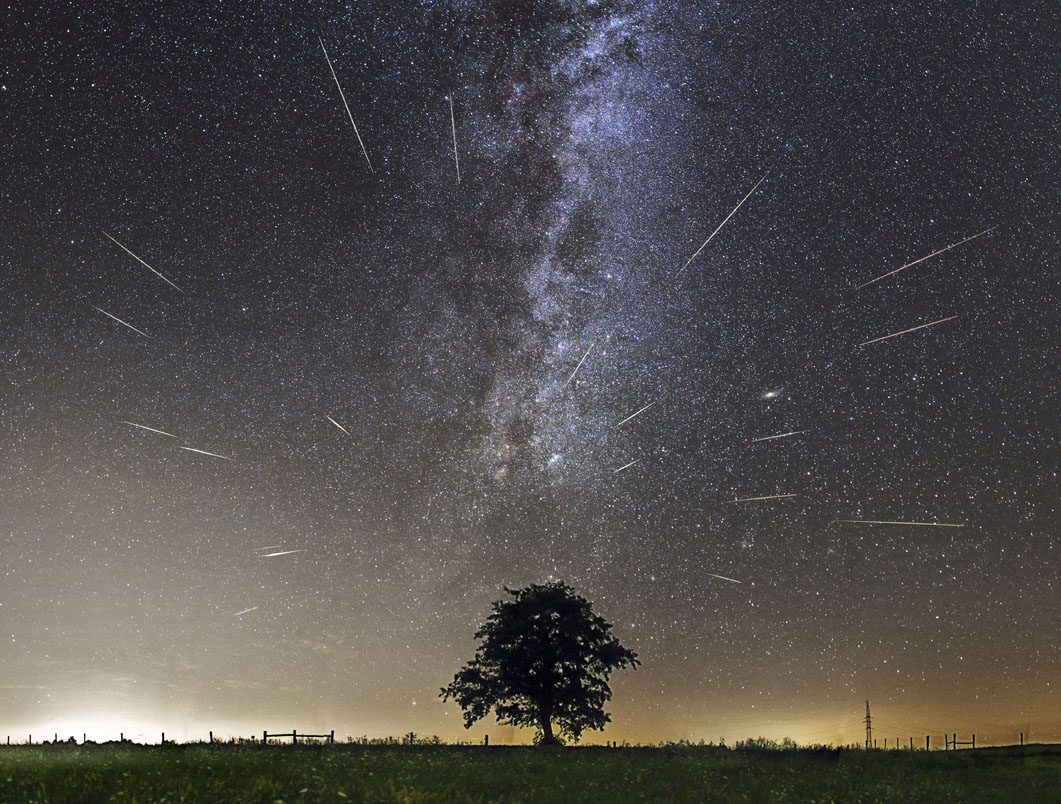
Rafael Schmall
With the Moon just three and a half days past new and setting around 10 p.m. local daylight-saving time, the stage is set for a splendid show of the annual Perseid meteor shower. Because the shower is active from mid-July to late-August, don't be surprised to see a few Perseids on any clear night in the next few weeks. But for the whole enchilada, plan to watch on the nights of August 11–12 when the shower is expected to reach maximum. There are indications the peak may even extend into the next night, so consider August 12–13 as well.
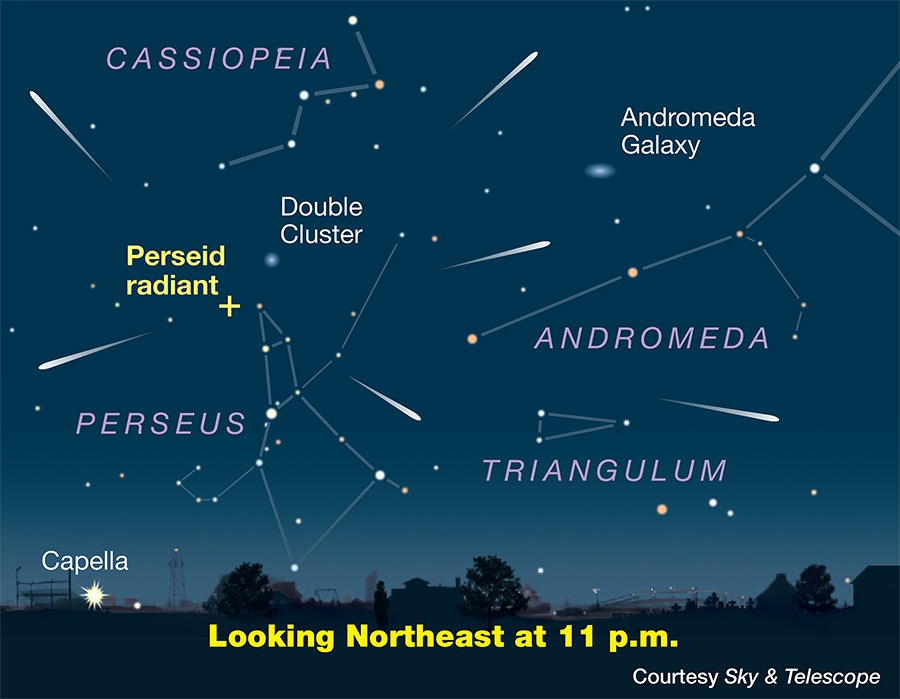
At peak, the zenithal hourly rate of the Perseids can reach 100 per hour, but this is an idealized number with the radiant at the zenith and stars visible to magnitude 6.5. Moreover, that rate might last only an hour. Most observers under good skies will see closer to 50 per hour and half that from areas that are light-polluted or under cover of wildfire smoke. To maximize your shower enjoyment, find as dark a site as possible.
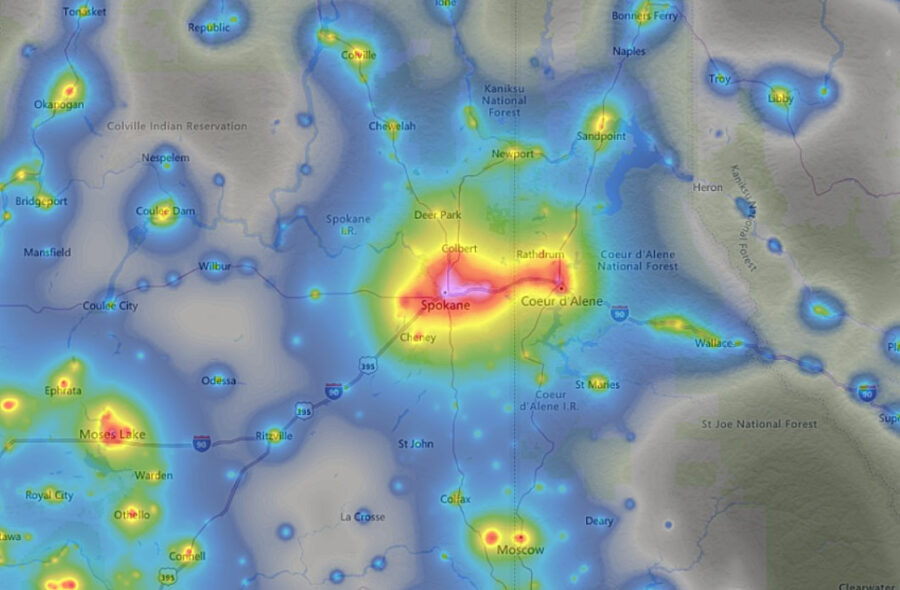
Jurij Stare, www.lightpollutionmap.info
If you can travel, use the interactive Light Pollution Map to identify the darkest skies in your area. Drag and scroll with your mouse to zoom into the region of interest which should be color-coded according to the amount of light pollution. Avoid the purple, red, and yellow zones and steer toward the night-sky-friendly gray regions.
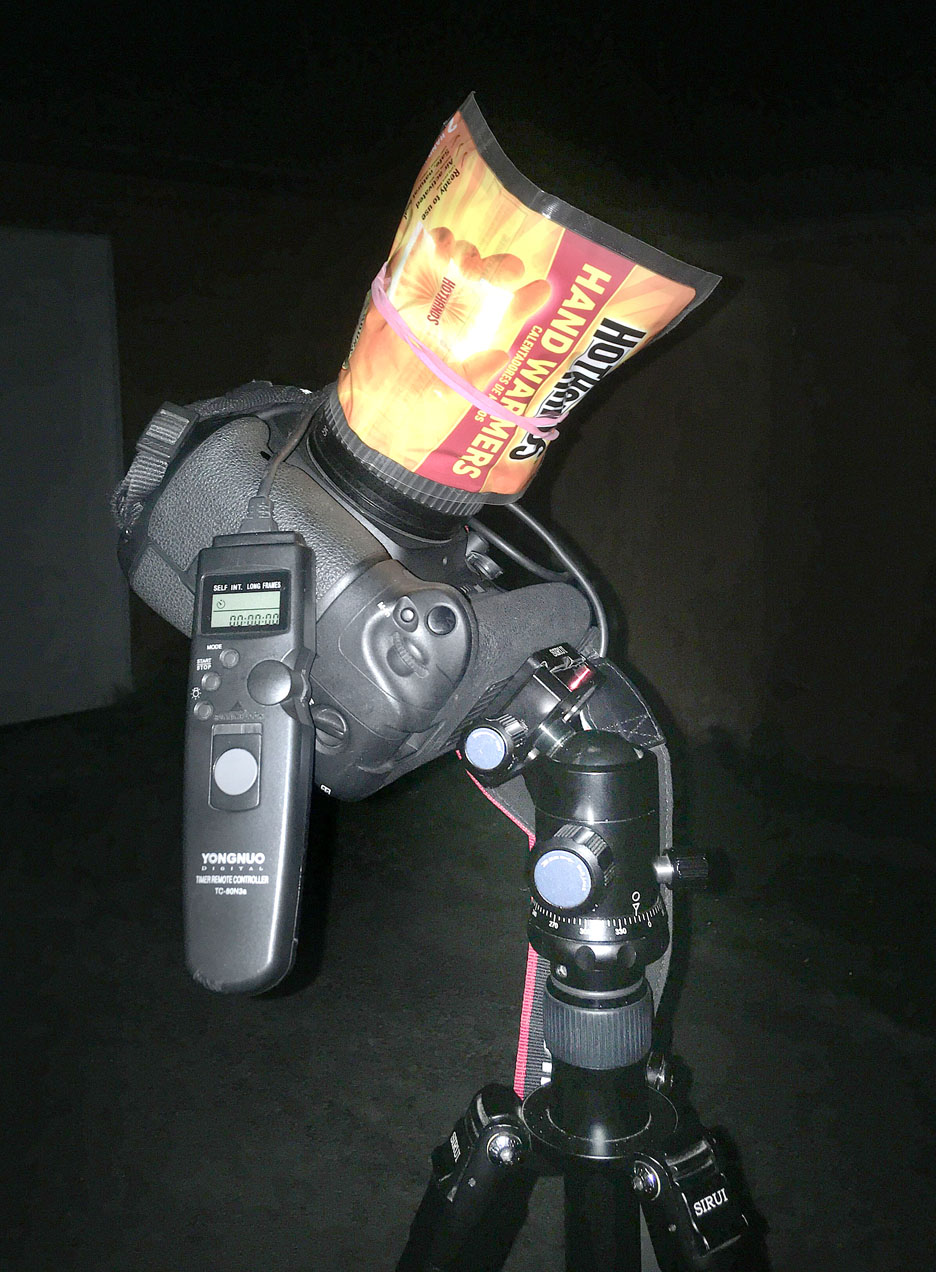
Bob King
Even under less-than-ideal skies, you'll still see plenty of meteors. I like to lie back in a reclining chair and enjoy what comes, letting my camera's intervalometer do the picture-taking. While you'll see meteors no matter what direction you look, I often face east-southeast so I can catch the "shorties" that appear near the radiant as well as the longer streaks at right angles to it.
Allow at least an hour for the shower. That'll give you time to get into the rhythm of the event as you watch the stars wheel above and Jupiter and Saturn rise into the southern sky. Both planets are at opposition this month and located in Capricornus. Jupiter offers a special surprise on the night of the 11th.
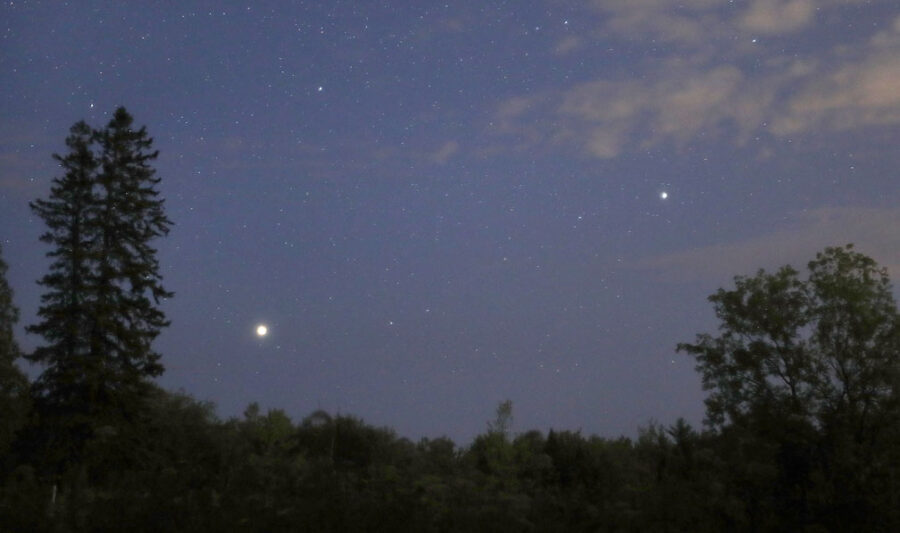
Bob King
From 10:42 p.m. until 1:07 a.m. Eastern Daylight Time (2:42–5:07 UT) , the big planet sports just one moon — Callisto, located 10′ due east. Io and Ganymede are behind the disk, while Europa and its shadow transit in front of it. It gets better. In the space of just six minutes between 1:07 a.m. and 1:13 a.m. (5:07–5:13 UT), Ganymede, Io, and Europa (in that order) rejoin the Jovian flock!
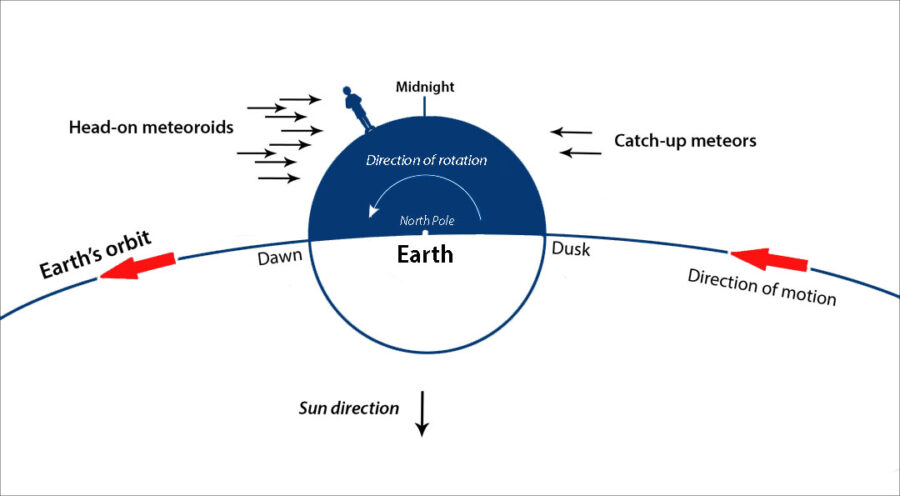
Bob King
A modest number of Perseids will be visible starting around 10 p.m. local daylight-saving time, when the radiant reaches 20° altitude in the northeastern sky. But the later you stay up the more you'll see: The hours between 2–4:30 a.m. are typically best. That's when the radiant climbs highest, and the fewest meteors are cut off by the horizon. After midnight, the Earth also rotates into the direction of the meteor stream, which increases the relative velocity at which meteoroids strike the atmosphere, pumping up their brightness, visibility, and number.
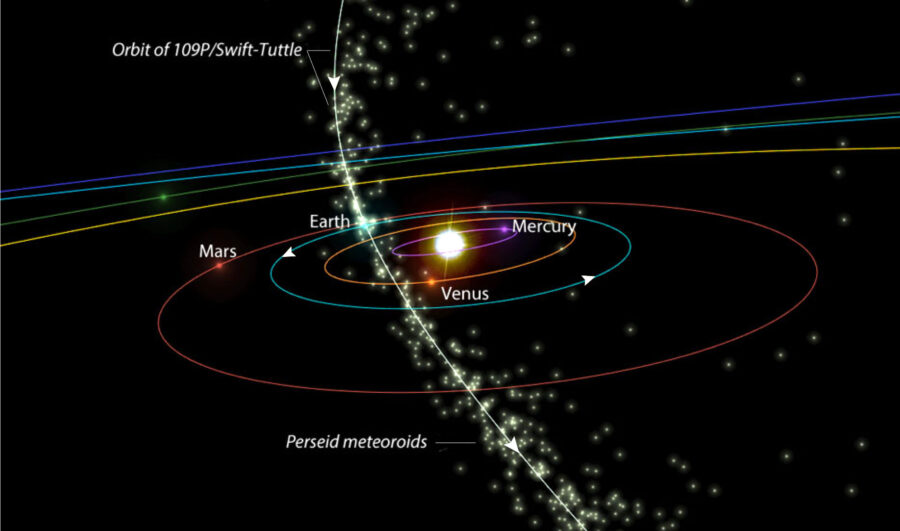
Visualization: Ian Webster / Data: NASA / CAMS / Peter Jenniskens (SETI Institute)
Perseids are the wayward children of their parent Comet 109P/Swift-Tuttle, a periodic comet that returns to Earth's vicinity every 133 years. It last reached perihelion in 1992 and will again in 2125. Each visit it lays down a spreading trail of dust resembling a jet contrail called a filament. Every August, the Earth intersects the comet's orbit and plows through the debris from a previous pass.
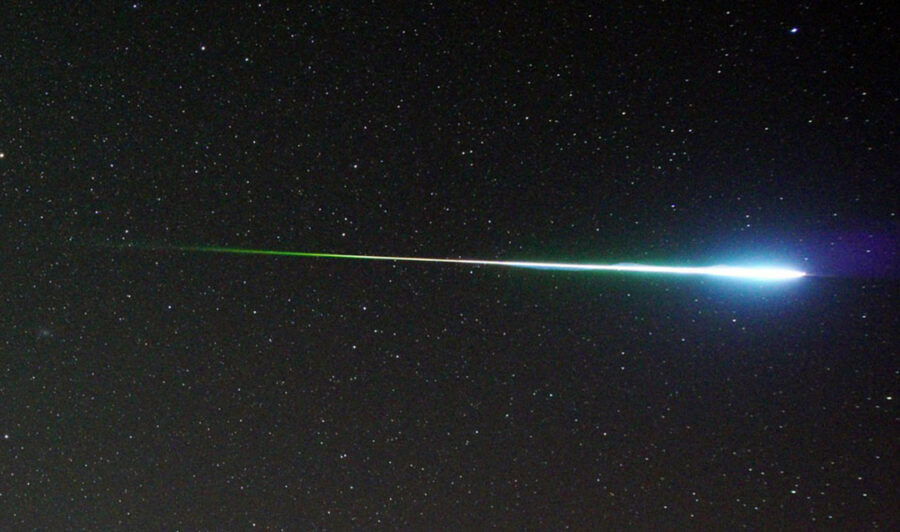
Siaraduz / CC BY-SA 4.0
As each grain slams into the atmosphere at around 60 kilometers per second, it creates a supersonic shock wave that compresses and heats the air in front of it. This in turn heats the meteoroid white-hot and burns it to soot. At the same time, the grain's passage excites (ionizes) the air molecules along its path. When the molecules relax back to their previous unexcited state, they radiate light. Both the glowing, hot bits of comet dust and trails of ionized air are responsible for the familiar meteor streaks. The average width of a meteor track is about a meter, while the length spans tens of kilometers. It's comprised of glowing, ionized air, and metal and silicate vapor from the meteoroid itself.
Not only are Perseids swift, they're famous for their fireballs, which are meteors of magnitude –3 or brighter. Bill Cooke of NASA’s Meteoroid Environment Office calls the Perseids the “fireball champion” of annual meteor showers. Cooke believes that’s because the parent comet has a larger than normal nucleus (about 26 kilometers) and is capable of producing the larger meteroid fragments that create brilliant flares.
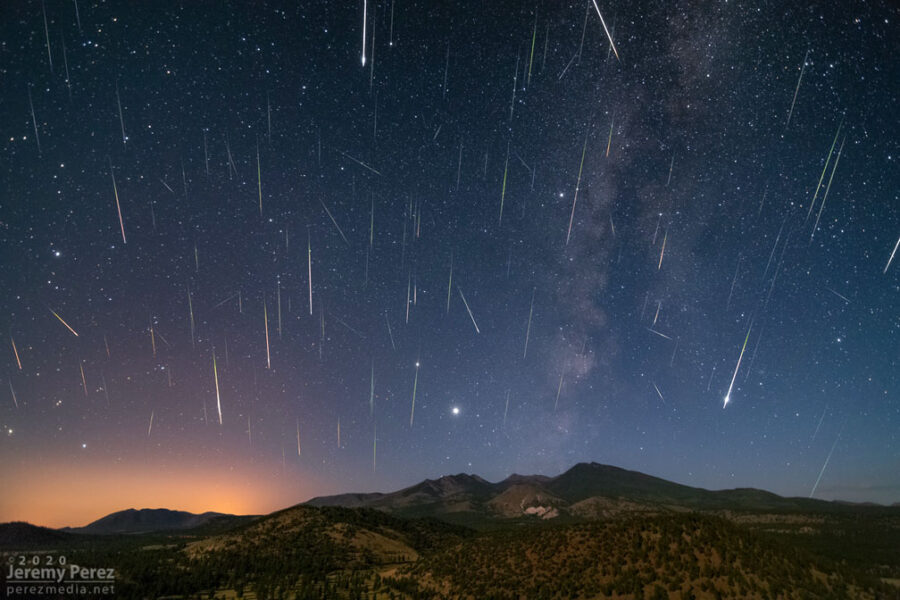
Jeremy Perez / perezmedia.net
The Perseids have been observed since at least AD 36 according to a Chinese record, but weren’t officially recognized as a recurring meteor shower until the late 1830s, when three European observers independently noted that an unusual number of meteors routinely appeared at the same time each August. Although their work led to the formal acceptance of the shower they weren’t the first to notice their repeated appearances. That honor goes to German and English Catholics who for centuries called the annual August meteor display theTears of St. Lawrence, after an early deacon of the church who was put to death by the Roman emperor Valerian on August 10 AD 258.
Whether you're watching from a mountaintop, shoreline, or just the backyard, go with the flow and enjoy the show. And if clouds interfere, astrophysicist and public astronomy enthusiast Gianluca Masi will stream the shower live on his Virtual Telescope site beginning at 8 p.m. EDT on August 11th. You can also head to the live feed of the Instituto de Astrofísica de Canarias starting at 7:15 p.m. EDT (23:15 UT) on August 12th.
 17
17









Comments
OwlEye
August 5, 2021 at 2:24 pm
Hi Bob,
Nice article; I really like the Light Pollution Map.
The best display of the Perseid meteor shower I have seen to date remains the very first one I observed on the evening of August 11, 1971, from my grandparents backyard in southwestern Delphos, Ohio. A cold front had brought heavy thunderstorms the previous evening that blasted through, with the huge harbinger drops falling as I was getting the telescope in from observing the excellent opposition of Mars.
The sky was crystalline all day on the 11th, and as it got dark I stood staring up at Cygnus. By the time the waning gibbous moon rose, I had lost count of how many Perseids I had seen. Almost all of them streaked through Cygnus, and none were fainter than 1st magnitude. They all exhibited these glittering, sparkling trains that lasted about one second each. It seems that the parent comet of this meteor stream - 109P/Swift-Tuttle - may have an ingredient other comets do not.
Here's hoping for clear, smoke-free skies for everyone in 2021!
DZ
You must be logged in to post a comment.
Bob KingPost Author
August 8, 2021 at 5:36 pm
Dear OwlEye,
Thanks for sharing a memorable night!
You must be logged in to post a comment.
BobMcNaught
August 6, 2021 at 6:29 pm
Hi Bob,
Excellent article, one of the best I've ever read.
The light pollution map even has my little village in England marked (Bortle 4 it says, but it's really 5).
It would be worthwhile to quote the estimated maximum, in UTC, as the best night varies around the world. Readers will then be able to decide on which night is the best.
As for smoke free skies... words fail me... beyond reminding me of a Victorian observer, whose words I have, complaining about terrible chimney smoke as he tried to observe in the 1840's from London.
Clear skies!
You must be logged in to post a comment.
Bob KingPost Author
August 8, 2021 at 5:35 pm
Thanks so much, Bob. I'll find the UTC and stick it in there. Thanks. I never stopped to consider how
smoke from coal burning so polluted the skies of the pre-electric era.
You must be logged in to post a comment.
DomeStarMan
August 6, 2021 at 6:53 pm
in 1982 I was visiting the northern hemisphere for the first time. I sat outside in a dark place on Vancouver Island with my young sun to look for Perseids. WOW! So spectacular - a life changing experience.
You must be logged in to post a comment.
Bob KingPost Author
August 8, 2021 at 5:33 pm
Hi DomeStarMan,
Now, that's a good shower on at least two counts — many meteors seen and seen in the company of your son. Thanks for sharing your observation!
You must be logged in to post a comment.
mshepard
August 9, 2021 at 8:08 pm
In the late 1970's a friend and I drove to a cornfield and watched all night. Fantastic display that culminated with a fireball that "hissed." The first and only time I ever experienced that.
You must be logged in to post a comment.
Bob KingPost Author
August 10, 2021 at 1:45 am
Dear M,
Wow! That's still something I'd like to experience. I have heard that some people can pick up electrophonic sounds. Me? Not so much apparently.
You must be logged in to post a comment.
Rod
August 12, 2021 at 8:15 am
I did observe a few Perseids early this morning. Perhaps only 4th magnitude based upon stars in Perseus and Capella I could see. Note from my stargazing log. [Observed 0500-0545 EDT/0900-0945 UT. I came out early this morning and observed 3 or 4 Perseids. They moved away from the radiant high up towards N and W sky traveling fast but faint. I compared to 3rd magnitude stars in Perseus for apparent magnitude estimate. Sunrise near 0618 EDT this morning or 1018 UT. The east horizon slowly brightening. Some owls were out hooting. There were t-storms the night before with many cirrus clouds remaining near midnight. Clear skies early this morning near 0900 UT. I sat in a chair in my backyard looking up high and scanning the sky. Stellarium and Starry Night show the Perseids move at 59 km/s compared to satellites or ISS orbiting at about 8 km/s.]
You must be logged in to post a comment.
Yaron Sheffer
August 12, 2021 at 3:57 pm
Hi Bob,
When you wrote "Not only are Perseids swift", I was thinking to myself "but they are also tuttle"... 🙂
You must be logged in to post a comment.
Bob KingPost Author
August 13, 2021 at 2:34 pm
Yaron,
🙂 🙂 Thank you for that keen and comic observation!
You must be logged in to post a comment.
David Oesper
August 15, 2021 at 3:23 pm
The Earth passed through an unexpected filament of Comet 109P/Swift-Tuttle, causing a spectacular enhancement of the Perseids on 14 Aug 0600 - 1000 UT, some 35 hours after the traditional peak (filament was at solar longitude ~141.5˚). Paul Martsching and I were observing NE of Ames, Iowa and saw single-observer observed rates of around 60 meteors per hour for an extended period. Many were bright (0th and 1st magnitude, some brighter). Paul's peak rate was 64 Perseids during the hour 0845 - 0945 UT.
A number of automated meteor cameras captured this event, but nothing can compare with seeing it visually under excellent conditions! I hope many others saw this event, but I suspect most visual observers did not go out, since it was after the predicted peak nights of Aug 11/12 and 12/13. A nice weekend surprise!
You must be logged in to post a comment.
Bob KingPost Author
August 15, 2021 at 4:24 pm
Hi David,
I totally agree with your assessment. I was also out that morning hunting comets in Duluth, Minn., thinking that numbers would be down. Was I ever surprised! The meteors shot at the rate of about one a minute. In just 45 minutes I counted 45 meteors with several nice fireballs. Even a "routine" shower like the Perseids can surprise. Thanks for your report.
You must be logged in to post a comment.
Ernie Ostuno
August 16, 2021 at 12:28 am
I was out between 0600 and 0700 UTC on the 14th, since it was the first really clear night in over a week, and only saw 7 meteors from my backyard in western Lower Michigan during that hour. Light pollution renders the Double Cluster and Andromeda galaxy barely visible to the naked eye, but that should not have cut down the numbers so dramatically. I wonder if the little bit of longitude between Michigan and Iowa/Minnesota made that big a difference?
The only really interesting thing I saw was two identical-looking first magnitude meteors following the same path between Beta and Alpha Andromedae about 5 seconds apart. This is something I have observed before with the Perseids. It seems like two meteoroids on the same same trajectory hit the atmosphere in rapid succession.
You must be logged in to post a comment.
Bob KingPost Author
August 16, 2021 at 1:08 am
Thanks, Ernie for sharing your numbers. It's possible longitude made a difference. Peak was 8.2 UT August 14, so your time was slightly off-peak but not so much. You might want to share your observation with the IMO (International Meteor Organization) at this address: https://www.imo.net/ so they can put together a more complete profile of the outburst.
You must be logged in to post a comment.
Mark Bratton
August 16, 2021 at 9:25 am
Thursday night/Friday morning was cloudy here from dusk til dawn, but tonight was clear and was going to be a telescope night, mostly observing bright summer objects. Over a couple of hours I did some sketches but I kept getting distracted by bright Perseids. The first of the night was a mag. -4 blazer and in all I saw seven Perseids without really trying while at the telescope. I decided to cover up the scope and spend the rest of the night observing Perseids.
Like Wednesday night, the transparency in my backyard was about average with a naked eye limiting magnitude of about +5.6. Observing from 12:30 to 3:30 a.m. CST, I counted a further 93 Perseids and 8 sporadics. About half the meteors left trails and were magnitude +2 to -2 in brightness. They often came in pairs in quick succession, following almost identical paths and there was a nice burst of seven Perseids over about 90 seconds at 2:15 a.m. The exactly 100 Perseids I observed tonight are triple the number of Perseids I was able to observe on Wednesday night, the supposed peak of the shower. It was probably one of the nicest Perseid displays I’ve seen.
You must be logged in to post a comment.
Bob KingPost Author
August 16, 2021 at 11:46 am
Excellent report, Mark. Thank you for sharing it with us.
You must be logged in to post a comment.
You must be logged in to post a comment.